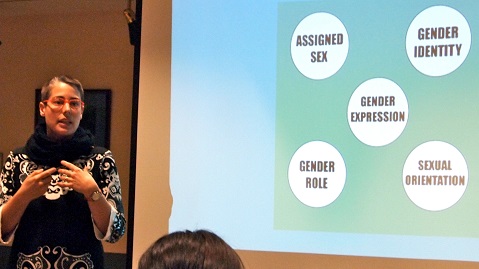Saving Hes and Shes
Central Coast EMTs Get Transgender Training

Transgender people identify with a gender identity different from the sex they were born with. For example, Chaz Bono, who has written a memoir on his transgender identity, was assigned female at birth. When his family first saw him, they thought he was a girl, but as an adult, Chaz communicated to his family that he identified as male and changed his pronoun from “she” to “he” to accurately reflect his identity.
Similarly, Janet Mock (who will be speaking at UCSB on Tuesday, April 29) was assigned male at birth. Her birth certificate says male, but her gender identity from a very young age was female. “I was born a baby. As soon as I had enough agency in my life, I became who I am.” Janet Mock changed her pronoun when she was a very young person from “he” to “she.” So, when we refer to Mr. Bono and Ms. Mock, we say, “Cher is his mother” and “Her book Redefining Realness is a New York Times best seller,” respectively.
Last month, Santa Barbara County paramedics were trained on how to ask transgender and gender nonconforming people for their pronoun preference. Next month, Ventura County emergency medical team will be training, too. This skill has the potential to transform the medical experience of Central Coast residents.
Gender is part of our essential sense of self from the time that we are first able to talk, as Bono’s and Mock’s stories make clear. It can neither be confirmed nor refuted by our anatomy. Non-transgender people (also referred to as cisgender people) often assume that genital surgery is an essential part of changing one’s gender identity. But surgery is rarely necessary or desired. The goal of transition is to be seen correctly as male or female. Many transgender people demonstrate their gender identity with their clothes and hair in order to be recognized correctly as male or female. In this they resemble most of us: gender-conforming cisgender people, who also demonstrate our gender identity with our clothes and our hair. Our gender identity has nothing to do with our anatomy.
Most transgender people lead healthy, happy lives without surgery and have a gender identity that is not reflected by their sexual anatomy. This fact poses a particular challenge to medical professionals who perform physical exams because they run the risk of misgendering patients based on anatomy. They might refer to patients by the wrong pronoun; for example calling a woman “he” or calling a man “she.”
Being misgendered, or called by the wrong pronoun, is a disturbing, uncomfortable, and potentially threatening experience. Because there is a higher chance of this happening in medical settings, transgender people often report avoiding or postponing medical care. And for medical staff, it can be uncomfortable not to know how to refer to a patient. It can even lead to avoidance due to embarrassment or conflict between clinical teammates who disagree on whether to call someone “he” or “she.”
In our training, Santa Barbara and county paramedics learned how to ask patients for their pronoun preference. They were told that when any of us is uncertain of someone’s gender, it is polite to inquire what their pronoun preference is, or, literally: “My partner and I want to refer to you correctly. What pronoun should we use?”
Paramedics do critical work. Confusion, disagreement, or embarrassment about not knowing someone’s gender identity can hinder this critical work. By asking this simple question, “What is your preferred gender pronoun?” paramedics are able to focus on the essentials of patient care. Angelo Salvucci, medical director for Santa Barbara County and Ventura County Emergency Medical Services Agency, had a hand in arranging the training and was pleased with its impact: “I was struck with how receptive and appreciative the EMTs and paramedics were to get this info. They were universally engaged and soaked it all up. It speaks to the caregiver mentality in all of us in health care. This equipped them to make a few more patients’ emergency health-care experience a little less traumatic.”
Mike Taigman, American Medical Response’s general manager for Ventura County and the Gold Coast who oversaw the delivery of this training to the teams in Ventura County, said: ”It’s disturbing to learn how little legal protection transgender people have in our country. While we work toward equal rights and protection, we can do our part by making sure that members of this community receive emergency health care that is top quality, respectful, and compassionate.”
Santa Barbara and Ventura County emergency medical professionals are to be praised for their compassionate and professional care of their patients.
Max Rorty, a licensed clinical social worker, trains medical and mental-health professionals on transgender competent care. A sample of her presentations can be viewed at maxrorty.com.



